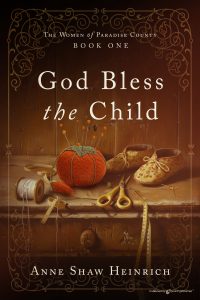Writing God Bless The Child
 The women in God Bless the Child have been tangled up in knots since I first created them nearly two decades ago. Bringing them back out into the light for a fresh look with older eyes and a wiser heart has led even their creator to marvel and wince anew at the raw ferocity that motherhood represents. Whether it comes about naturally, by human design, and even when it leaves a gaping, unanswered void, the mother/daughter sphere offers much to explore.
The women in God Bless the Child have been tangled up in knots since I first created them nearly two decades ago. Bringing them back out into the light for a fresh look with older eyes and a wiser heart has led even their creator to marvel and wince anew at the raw ferocity that motherhood represents. Whether it comes about naturally, by human design, and even when it leaves a gaping, unanswered void, the mother/daughter sphere offers much to explore.
Heavyweight Mary Kline and her vulnerable friend Pearl Davis are bound to one another as young outcasts long before Pearl’s baby, Elizabeth, is born. With parents eager to keep their great big girl satisfied, Mary swoops in with gestures for her friend and the baby that look plenty grand from afar, but throb with a desperate need that has a pulse of its own. Mary knows she’s smothering but cannot stop herself. Poor Pearl is just along for the ride. Elizabeth evolves into a child who recognizes early on that neither her birth nor surrogate mothers are fully equipped to give her what she needs.
Bound by needs both practical and primal, these three characters find themselves fenced in by circumstances beyond their control. Still, they are tied by a measure of complicated love that can only be understood from the world they share.
Just like a mother, an author should not have favorites, but I have to admit that I’ve always had a soft spot for Mary Kline. Long ago, a would-be agent suggested that I dial parts of this character way, way back. I resisted. Nearly twenty years later, I like her even more. (Mary, not the agent.) Yes, she’s needy and generous all at once. Sometimes she’s pathetic, but just as many times throughout the book, beneath all the insecurities and smothering tendencies, she has a surprisingly firm grasp of natural mothering instincts. As we learn just how starving she’s been for a mother’s love herself, it is nothing short of a miracle that this character is still standing in, even as a surrogate parent. Mary’s resilience still makes me weep. I am glad I fought for her.
I’m nearly as soft in my center about Pearl Davis, but I did stick with my initial choice to reveal what readers know about her through the narratives of other characters. She has neither the voice nor the autonomy she deserves in the book or throughout the life I imagined for her. The injustice on both fronts serves purpose. It makes the other characters and readers uncomfortable. And in our squirming, we wonder what did this woman know about her place in the world, her value? What could she perceive, and which hard truths eluded her? We identify the moments in her life when the choices of others change everything for Pearl and her daughter, Elizabeth. We wish we could hear her voice.
Elizabeth suffers plenty. Intergenerational trauma flows freely through her veins, but her hard-hearted responses make her challenging to love without effort. She meets Mary’s smothering generosity with resentment. She’s ashamed of both her mothers and frustrated by all that is left untended by these two women she’s found herself saddled with. It’s not until Elizabeth struggles as a mother herself that this complex character has the information she needs to see Mary, Pearl, and herself, with a softer redemptive lens.
The other characters in the book also carry with them narratives loaded with conflict, observation, and growth. Like most of us, they have capacities to expand and contract their own generosity of spirit depending on what’s at stake in the moment and how they are feeling about themselves. As humans, we know this, but still allow ourselves to wound and be wounded, leave and return, harbor grudges, forgive and love.
I do not know anyone in my real world who is exactly like any of the characters that made it to the pages of God Bless the Child, but I do observe people, often wondering which cards they hold and which ones they fold. Where are they going and where have they been? What do they carry with them from place to place and what are they willing to leave behind? Somewhere in the shadows of those imaginings lies the start of a story.
—
Anne Shaw Heinrich lives in Kirkwood, MO. Her debut novel, God Bless the Child, will be released in June 2024. It is the first in a three-book series, The Women of Paradise County, to be published by Speaking Volumes. To learn more about Anne, visit anneshawheinrich.com.
GOD BLESS THE CHILD
 When we first meet Mary Kline in God Bless the Child, Book One of The Women of Paradise County series, she is sewing, her main obsession besides eating. It is hard to blame Mary for who she has become. She’s been perpetually hungry since childhood, and as she becomes a woman, she craves something far more delicious—a child of her own.
When we first meet Mary Kline in God Bless the Child, Book One of The Women of Paradise County series, she is sewing, her main obsession besides eating. It is hard to blame Mary for who she has become. She’s been perpetually hungry since childhood, and as she becomes a woman, she craves something far more delicious—a child of her own.
When Pearl Davis turns up pregnant after a church-basement encounter with James Pullman, the pastor’s son, Mary and her parents swoop in and “adopt” Pearl and her baby, Elizabeth. It’s a disastrous move.
As a teen, Elizabeth rebuffs Mary’s smothering affection and winds up pregnant. Mary insists on an abortion, which they both keep secret. When she later becomes a young mother, Elizabeth’s depression leads to severe OCD. When her irrationally patient husband, David, learns about the abortion and the harrowing nights Elizabeth witnessed as a child when her birth mother was abused, more secrets are revealed that explain Mary Kline’s insatiable appetite and her desire to be loved.
By the time Mary and Elizabeth confront the twisted truths that bind them, their entire family is sucked into grappling with layers of trauma spanning three generations.
Everyone in God Bless the Child must reckon with their past as they seek forgiveness and redemption.
BUY HERE
Category: How To and Tips























